Amazon vs. Walmart: The Growth & Future of Ecommerce
This report compares the world’s two biggest retailers — Amazon and Walmart. Through analysis of data from more than 1,000 U.S. consumers and financial reports from Amazon and Walmart.com, we reveal insights into shopping preferences and growth indicators for both ecommerce giants.
Read the report
Key Insights:
- Amazon is maintaining its ecommerce dominance — for now. Despite a yearlong streak of quarter-over-quarter growth in the high double digits, Walmart’s ecommerce sales trajectory has tempered in 2022.
- Walmart’s advantage over Amazon in the grocery sector — a byproduct of its brick-and-mortar presence and reputation for low prices — has strengthened this year. As inflation continues to impact spending and shopping habits, more than half of U.S. consumers most often turn to Walmart for groceries, compared to 15% who most often buy them from Amazon.
- The year ahead will be a proving ground as each company executes strategies to narrow their competitive gulfs: for Amazon, an evolving physical retail and grocery presence steeped in advanced technology; for Walmart, expansion of its omnichannel ecommerce business and online Marketplace.
By the Numbers: Key Comparisons
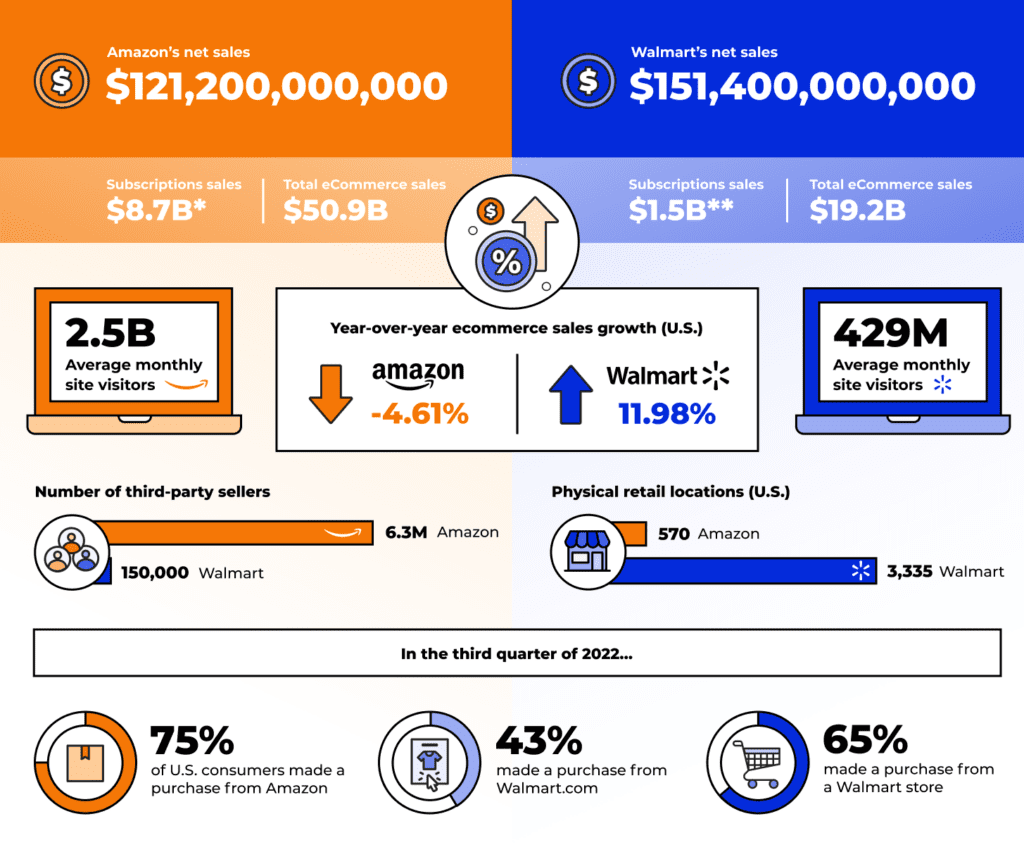

*Includes fees associated with Amazon Prime memberships, as well as digital video, audiobook, digital music, e-book, and other non AWS subscription services.
**Includes fees associated with Walmart Plus memberships
About the report
Methodology
The analysis included in this report combines data from Jungle Scout’s most recent Consumer Trends Report, a quarterly, anonymous survey of over 1,000 adult U.S. consumers about their buying preferences and behaviors, and from our annual State of the Seller survey of more than 3,500 first-and third-party Amazon and/or Walmart sellers.
Using the data
We encourage you to explore the report and to share, reference, and publish the findings with attribution to “Jungle Scout” and a link to this page.
For more information, specific data requests, or media assets, or to reach the report’s authors, please contact us at
[email protected].
About Jungle Scout
Jungle Scout is the leading all-in-one platform for ecommerce sellers, supporting more than $50 billion in annual Amazon revenue. Founded in 2015 as the first Amazon product research tool, Jungle Scout today features a full suite of best-in-class business management solutions and powerful market intelligence resources to help entrepreneurs and brands manage their ecommerce businesses. Jungle Scout is headquartered in Austin, Texas and supports 10 global Amazon marketplaces.
Related Industry Reports
Amazon vs. Walmart: The Growth & Future of Ecommerce
This report compares the world’s two biggest retailers — Amazon and Walmart. Through analysis of data from more than 1,000 U.S. consumers and financial reports from Amazon and Walmart.com, we reveal insights into shopping preferences and growth indicators for both ecommerce giants.
Thanks! Read our comprehensive analysis of Amazon and Walmart.

Read more
Introduction
The world’s two largest retail corporations — Amazon Inc. and Walmart Inc. — are at the forefront of a rapidly evolving consumer shopping experience that’s becoming increasingly focused on ecommerce. Their respective histories are markedly different, but a rapidly changing global economy has forced them to embrace diversification strategies and adapt as competitors.
In 2022, Amazon’s long-held staple status among online shoppers — and sellers — is facing competition from Walmart’s strategic push into ecommerce. The two companies’ recognition and vast fulfillment networks are representative of key commonalities, but distinct differences — such as Amazon’s streaming services and Walmart’s unparalleled brick-and-mortar presence — give each an edge among different audiences.
This report focuses on how each retailer’s history has shaped its current success, what distinguishes Amazon from Walmart.com in the eyes of consumers, sellers, and advertisers, and what may lie ahead for these retail giants – and retail at large – in the future.
Key Takeaways
Amazon is maintaining its ecommerce dominance — for now. Despite a yearlong streak of quarter-over-quarter growth in the high double digits, Walmart’s ecommerce sales trajectory has tempered in 2022.
Walmart’s advantage over Amazon in the grocery sector — a byproduct of its brick-and-mortar presence and reputation for low prices — has strengthened this year. As inflation continues to impact spending and shopping habits, more than half of U.S. consumers most often turn to Walmart for groceries, compared to 15% who most often buy them from Amazon.
The year ahead will be a proving ground as each company executes strategies to narrow their competitive gulfs: for Amazon, an evolving physical retail and grocery presence steeped in advanced technology; for Walmart, expansion of its omnichannel ecommerce business and online Marketplace.
By the Numbers: Key Comparisons


*Includes fees associated with Amazon Prime memberships, as well as digital video, audiobook, digital music, e-book, and other non AWS subscription services.
**Includes fees associated with Walmart Plus memberships
Rivalry Timeline
While Amazon has been an ecommerce retailer from the start, the 60-year-old Walmart has branched into ecommerce more recently, thanks to a series of strategic acquisitions.
Timeline of Walmart.com
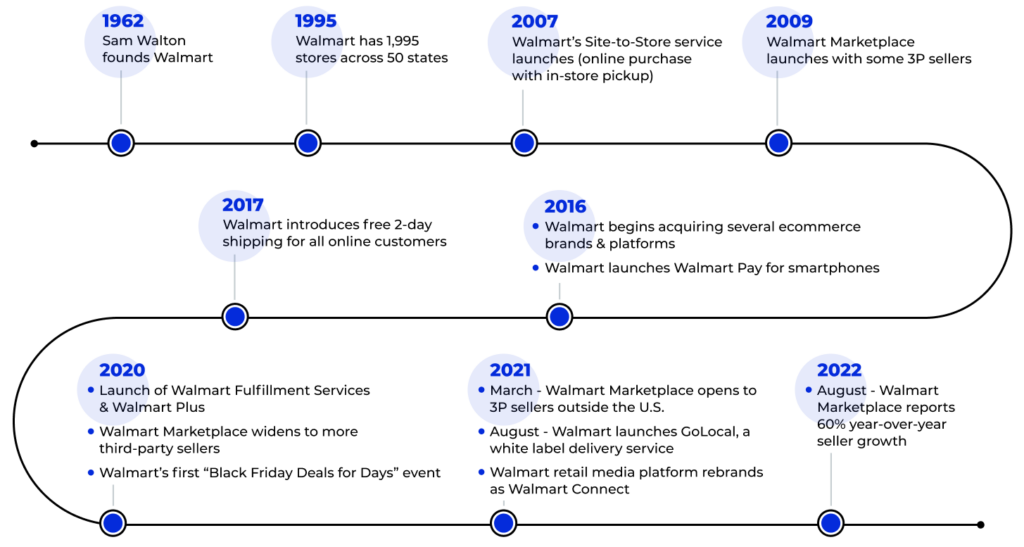

*Read our guides to using Walmart Marketplace and Amazon FBA to learn more
“We’re becoming more digital, even more relevant as an omnichannel retailer, and the related businesses like fulfillment and advertising continue to grow. We’re building a different business and we’re making progress.”
Timeline of Amazon.com
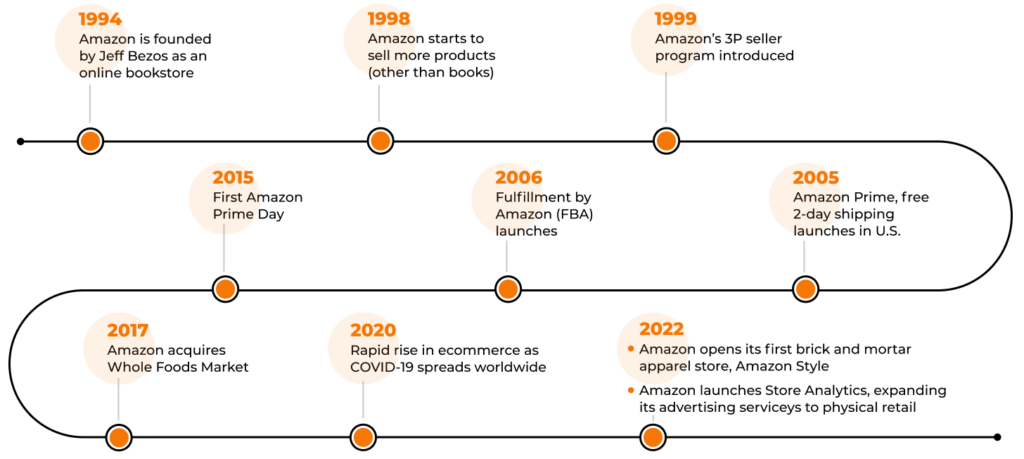

*Read our guides to using Walmart Marketplace and Amazon FBA to learn more
Shoppers and Sellers
What compels consumers to shop on Amazon vs. on Walmart.com?
Though Amazon and Walmart.com have similar appeals — huge product catalogs, affordable and fast shipping, and great prices — consumers value them for different reasons.
Reasons customers shop at…
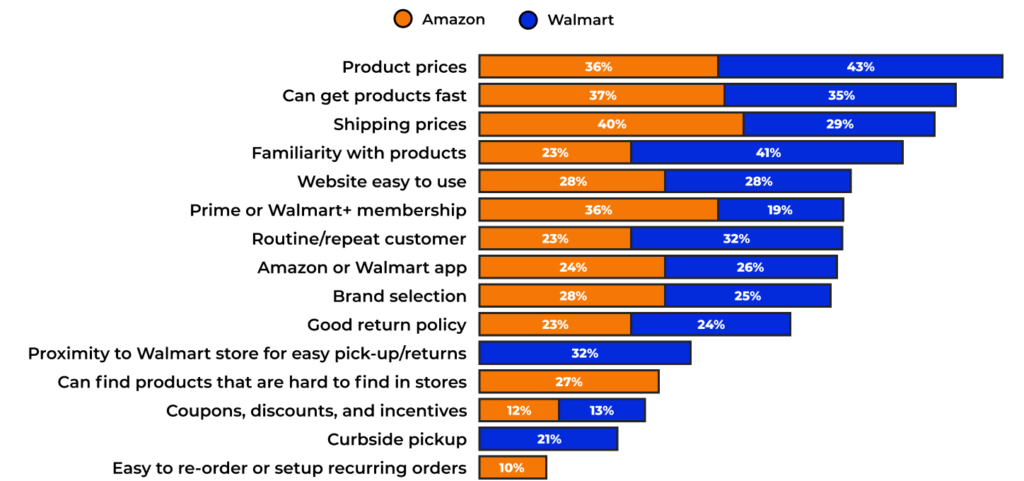
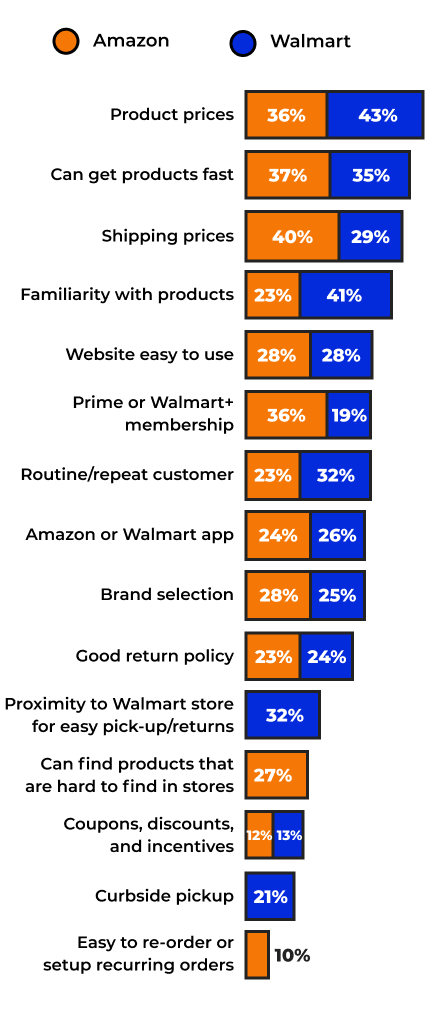
Consumers consider product pricing more than any other factor in deciding to shop at Amazon versus Walmart.
How frequently consumers shop on Amazon and Walmart.com
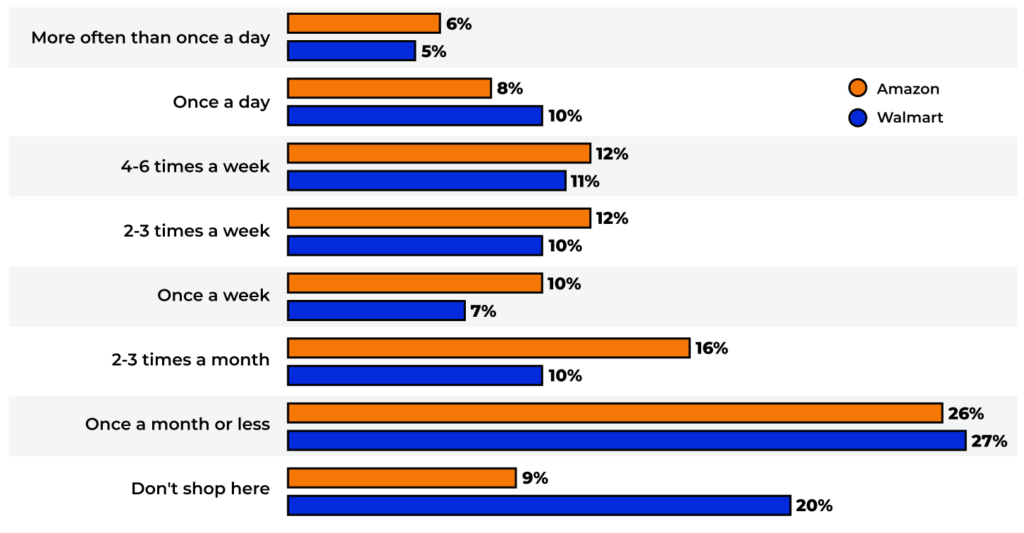
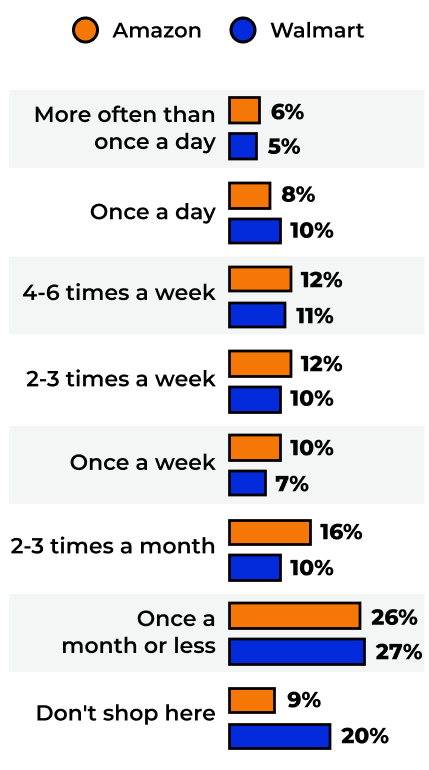
48% of consumers shop on Amazon at least once per week
43% of consumers shop on Walmart.com once per week
48% of consumers shop on Amazon at least once per week
43% of consumers shop on Walmart.com once per week
Where consumers start their search for products online
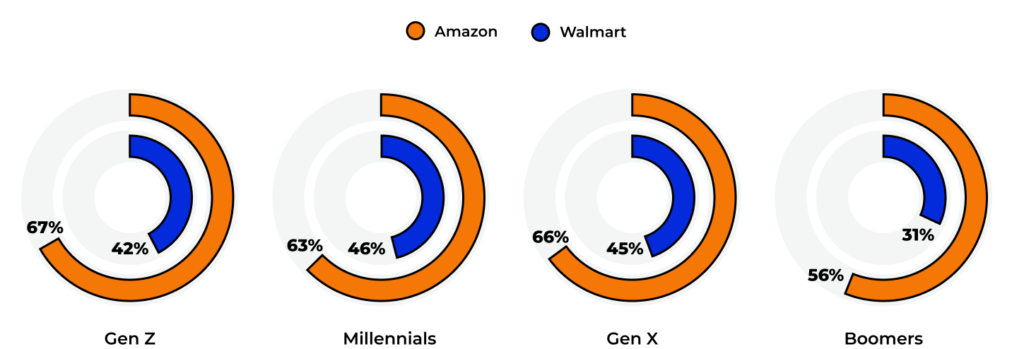

Gen Z shoppers are more likely than any other generation of consumers to begin their search for a product online at Amazon (67%) over Walmart.com (42%)
Category preferences
Where consumers are more likely to shop by product category
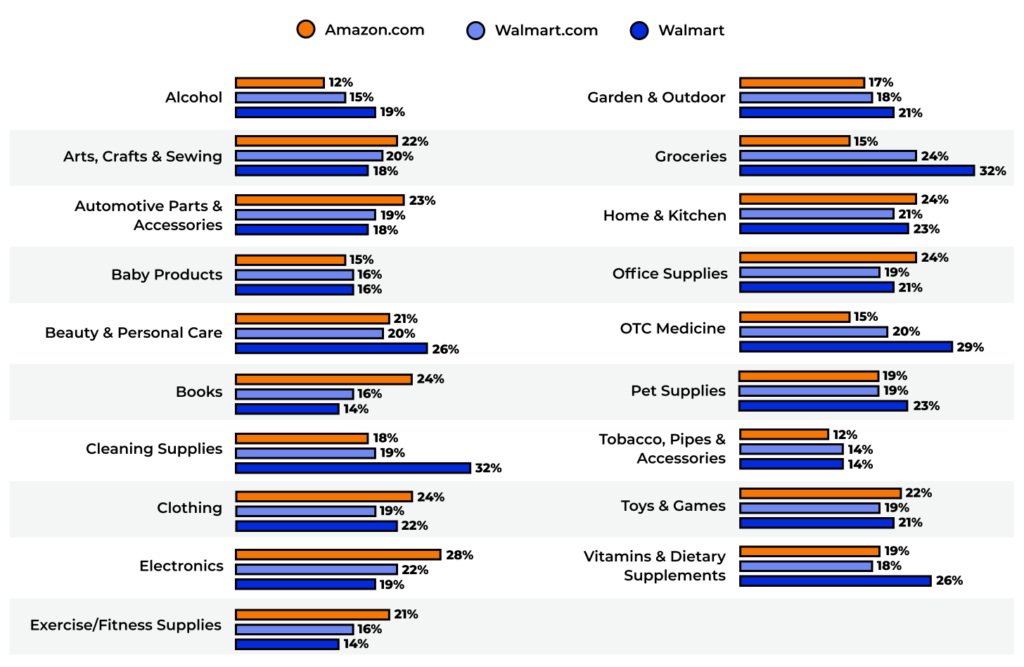

Demographics and spending
Quarterly consumer spend at Amazon vs. Walmart*
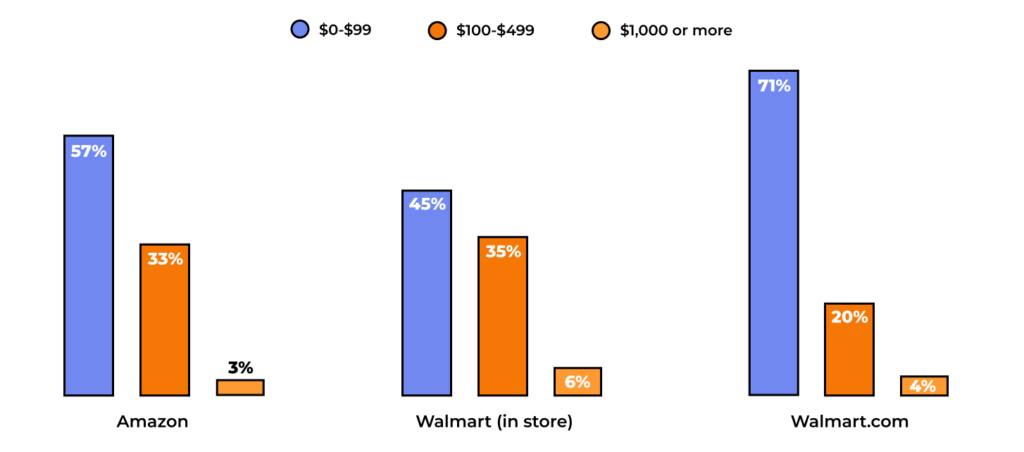

*Percentages represent the portion of consumers who reported spending in the corresponding ranges in the third quarter of 2022.
While consumers are spending less overall in 2022 amid an economic downturn and record inflation, their spending at Amazon and Walmart is relatively stable compared to a year ago.
Quarterly consumer spending at Amazon vs. Walmart by generation*
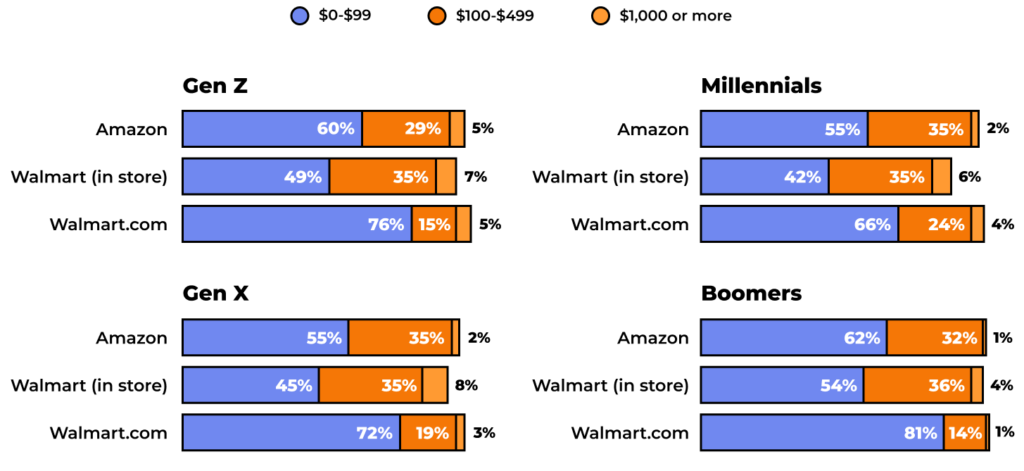
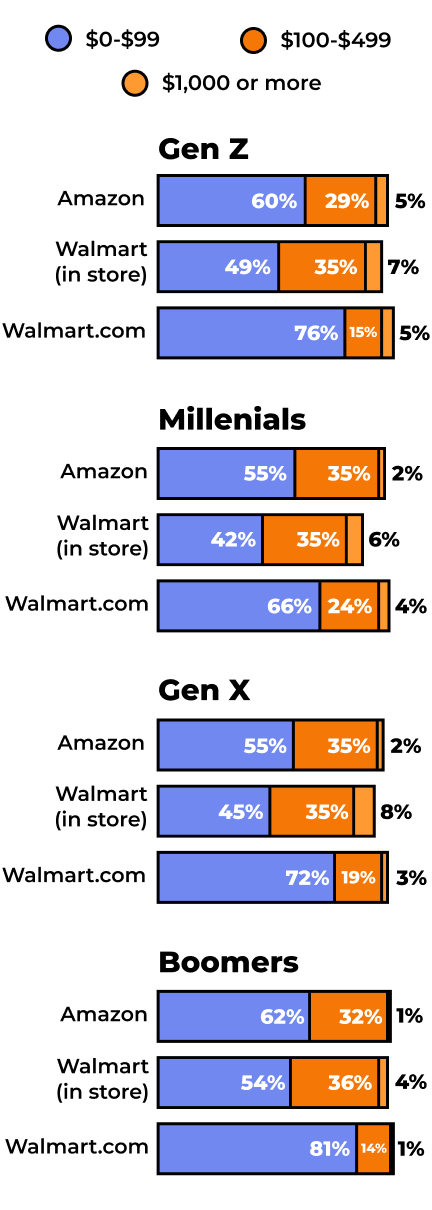
Seller Profiles
As Walmart expands further into ecommerce, it has welcomed more than 150,000 third-party ecommerce sellers into Walmart Marketplace, many of which also sell on Amazon. A side-by-side comparison derived from Jungle Scout’s 2022 survey of more than 3,500 ecommerce sellers reveals key similarities and differences.
Amazon and Walmart sellers at-a-glance*
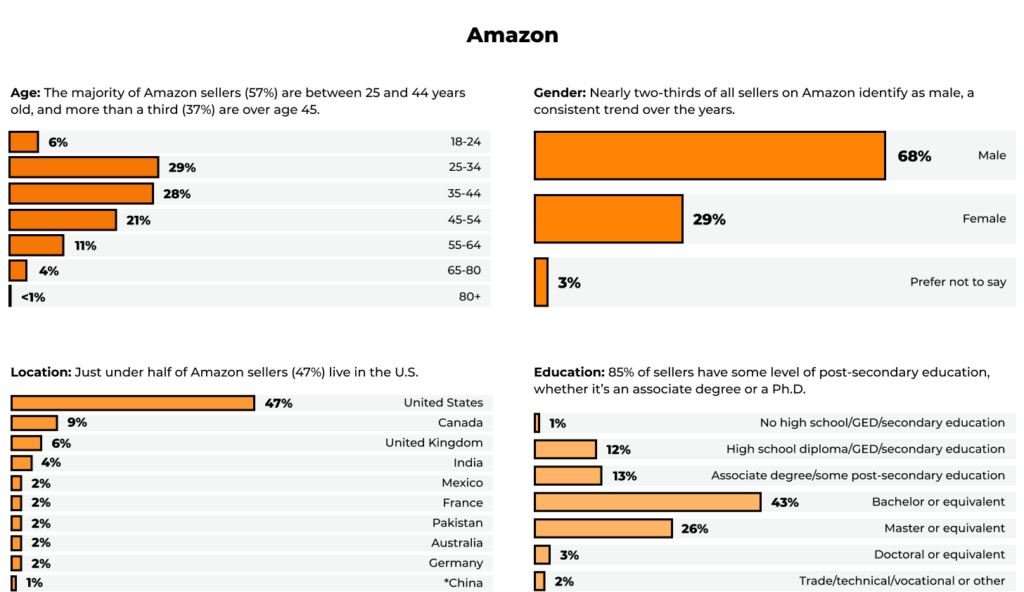

Read more about different seller approaches between male and female Amazon sellers here.
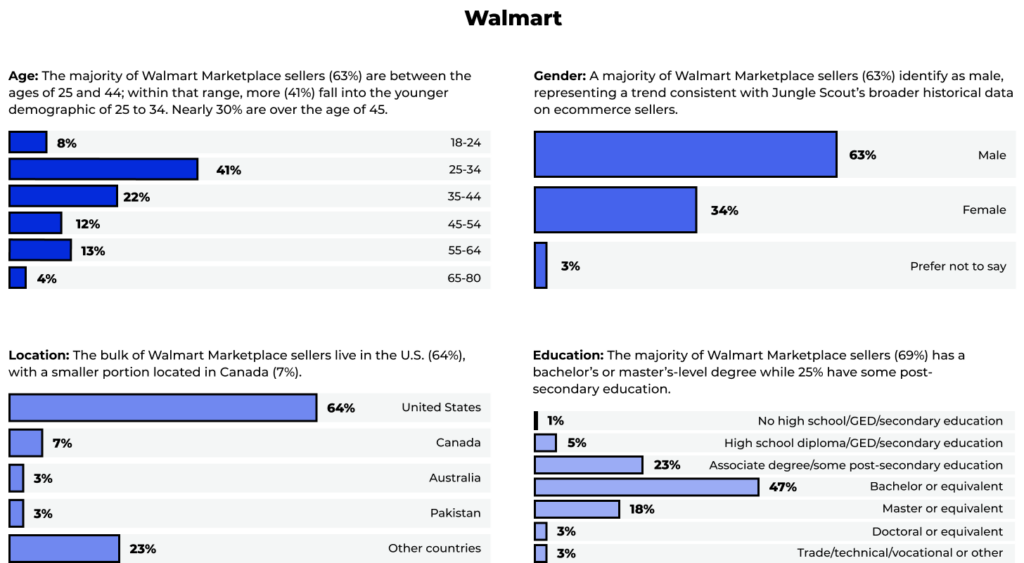

Amazon Sellers
The term “Amazon seller” is often used to refer to the third-party or “3P” sellers whose small businesses and brands generate over half of Amazon’s annual ecommerce sales. There are also “first-party” or “1P” sellers who sell their products to Amazon as a vendor. Finally, there’s Amazon itself.
Types of Amazon sellers
First-Party (1P) Seller
Sells to Amazon as a vendor and use Vendor Central
Third-party (3P) Seller
Sells on Amazon’s platform and use Seller Central
Agency
Works with sellers as a consultant or partner, helping manage their Amazon businesses
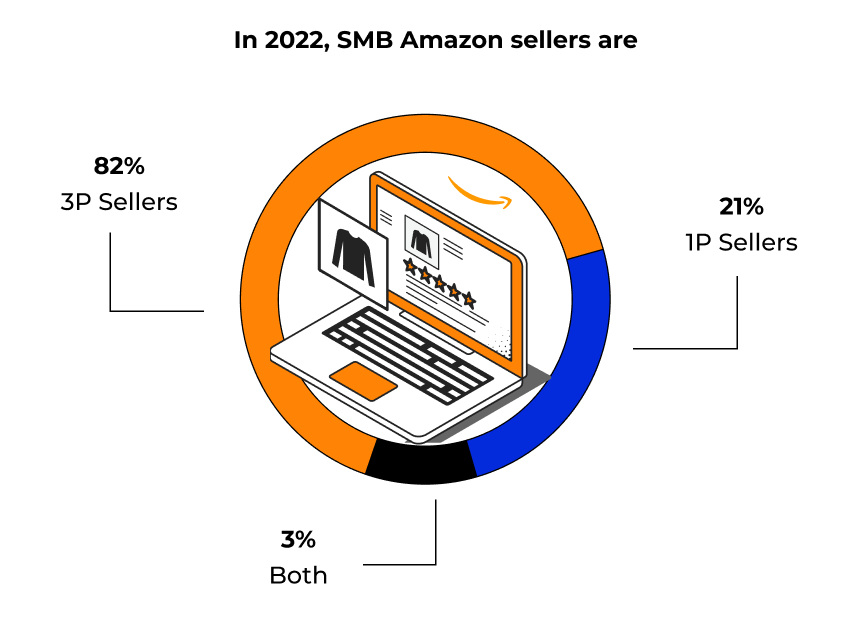
Walmart Sellers
There are three ways to sell on Walmart Marketplace. Following the completion of an application review process, Walmart invites new sellers to set up Marketplace accounts in the following categories:
First-Party (1P) Seller
sells products to Walmart in bulk, at wholesale prices. When a customer buys a 1P product, Walmart is listed as the seller. Walmart controls the product listing, marketing, pricing, and order fulfillment. 1P resembles a traditional supplier or wholesaler relationship.
Third-party (3P) Seller
sells products on Walmart Marketplace and controls the product’s listing, marketing, and pricing. Typically, 3Ps handle their own order fulfillment, but many use Walmart Fulfillment Services (WFS) or third-party fulfillment centers.
Dropship Vendor (DSV)
sells products to Walmart at wholesale prices, but not in bulk. Walmart is listed as the seller. However, the DSV handles inventory storage and order fulfillment.
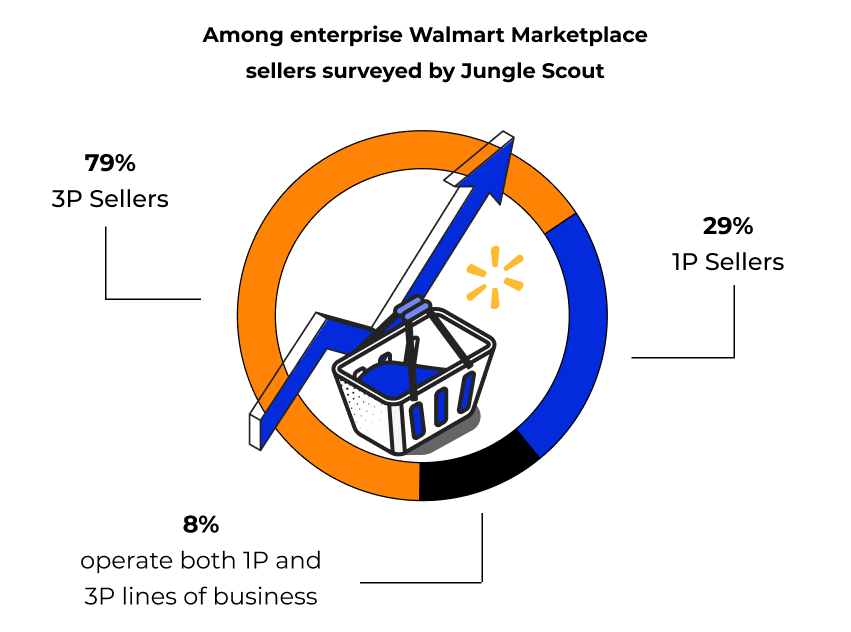
Forward-Looking Strategies, In-Store and Online
After the Covid-19 pandemic broadly accelerated consumer appetite for shopping online, the ecommerce landscape has exploded into a massive economy ripe with innovation. At the same time, brick-and-mortar retailers are evolving their offerings in an attempt to compete — and in some cases stay relevant — to consumers.
As the two biggest names in the industry, the strategies in motion at Amazon and Walmart are at the forefront. At Amazon, where the company’s history has given it the leading edge in ecommerce and technology, strategic, successful movements into physical retail could fortify future industry dominance. With Walmart, which unquestionably overpowers Amazon in physical retail — and thus wins customers looking for convenience, particularly within the categories we’ve outlined above — the same could be said about its push into ecommerce.
Membership growth
Walmart is a few years into a broad and aggressive move into ecommerce with the expansion of Walmart Marketplace. It’s Walmart Plus membership program has been a pivotal element of this push as the company looks to win new customers and broaden awareness of its online offerings to its loyal in-store customers.
Offering convenience and discounts on products and shipping, Walmart Plus has much in common with Amazon’s Prime membership program. Key differences between Amazon Prime and Walmart Plus include price, Amazon’s streaming services, and Walmart’s in-store benefits.

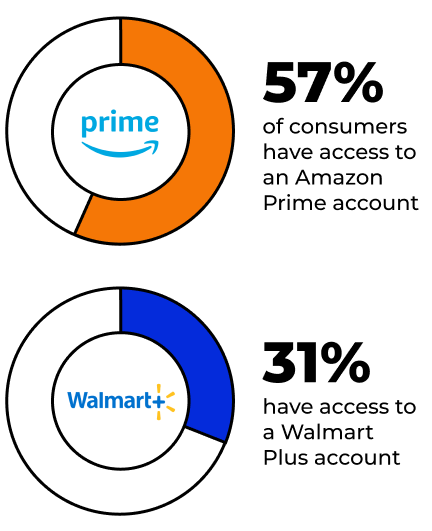
Amazon Prime vs. Walmart Plus: Terms & Benefits
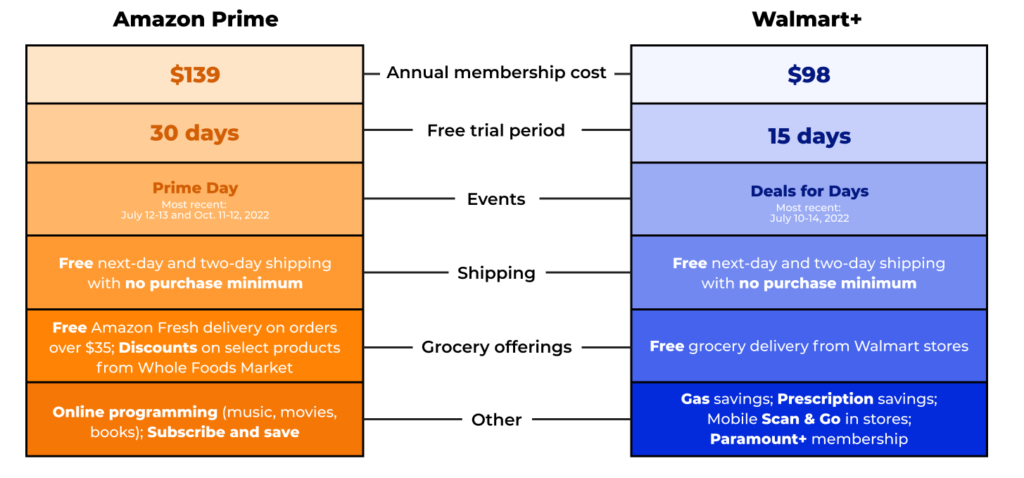
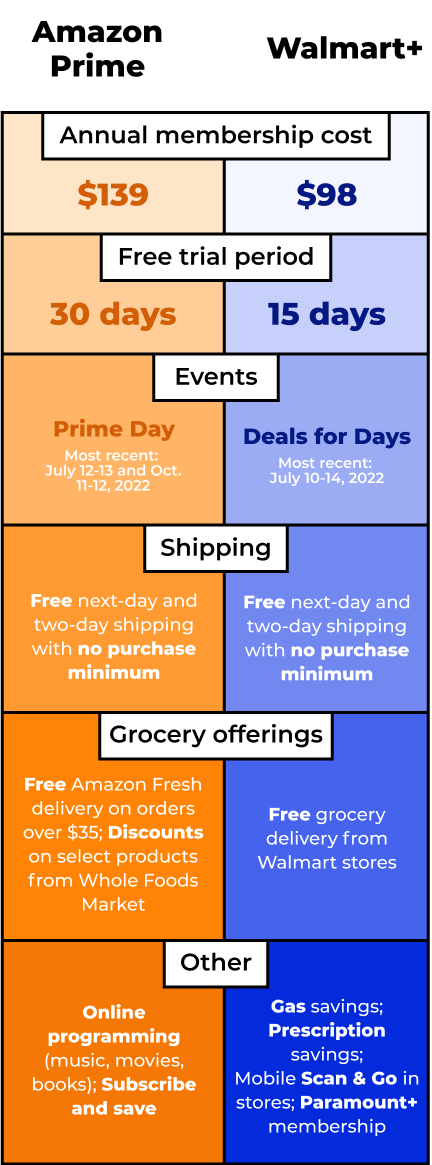
The future of in-store shopping, increasingly enabled with ecommerce
Grocery
Amazon’s expansion into grocery at both high and low price points (Whole Foods Market and Amazon Fresh) appeals to a wide range of consumers. In 2022, the company announced two significant milestones in its efforts to add grocery customers:
- Supplemental Nutrition Assistance Program (SNAP) EBT benefits now accepted in Amazon stores and online across 48 states and the District of Columbia
- Opening of more than 14 new Amazon Fresh store locations


Technology
Amazon’s history as a tech company has given it the leading edge in its own physical store locations – and those of the brands/sellers it serves. However, Walmart has followed, rolling out a number of new high-tech offerings to both in-store and online customers.
Recently implemented tech offerings across Amazon, Walmart stores and ecommerce platforms
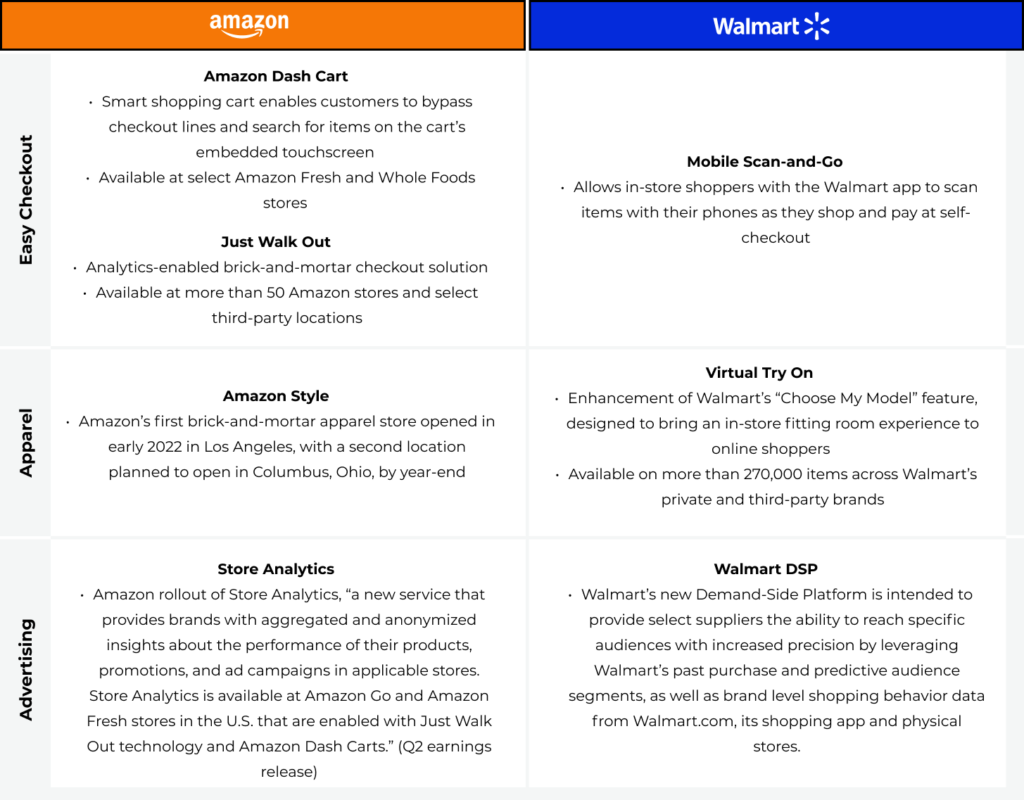

About the report
Methodology
The analysis included in this report combines data from Jungle Scout’s most recent Consumer Trends Report, a quarterly, anonymous survey of over 1,000 adult U.S. consumers about their buying preferences and behaviors, and from our annual State of the Seller survey of more than 3,500 first-and third-party Amazon and/or Walmart sellers.
Using the data
We encourage you to explore the report and to share, reference, and publish the findings with attribution to “Jungle Scout” and a link to this page.
For more information, specific data requests, or media assets, or to reach the report’s authors, please contact us at
[email protected].
About Jungle Scout
Jungle Scout is the leading all-in-one platform for ecommerce sellers, supporting more than $50 billion in annual Amazon revenue. Founded in 2015 as the first Amazon product research tool, Jungle Scout today features a full suite of best-in-class business management solutions and powerful market intelligence resources to help entrepreneurs and brands manage their ecommerce businesses. Jungle Scout is headquartered in Austin, Texas and supports 10 global Amazon marketplaces.


